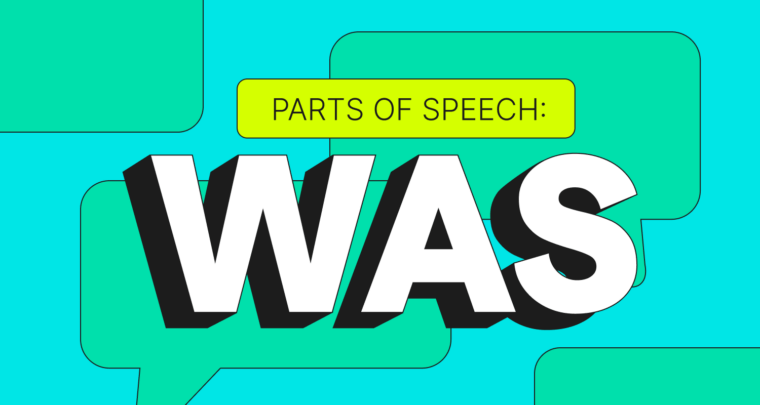
The eight parts of speech in English grammar are like ingredients in a recipe—each plays a role in creating a well-composed finished product, but only if you know how to use them properly. Incorrectly using a part of speech can make your sentence grammatically incorrect or hard to understand, just as misusing an ingredient can change your dish’s taste.
This includes the word was, an important word when writing sentences in the past tense. Consider this blog post a cookbook that explains what part of speech the word was is, how verbs like it are used in sentence construction, and how to use it in a sentence.
What part of speech is the word was?
The word was is a verb, which is a part of speech that describes an action or a state of being. It’s the past tense first- and third-person singular of “to be,” which means “to take place or occur.” Was is used to express an action done in the past. The word derives from the Middle English word wæs.
The basics of parts of speech
There are eight parts of speech in the English language.
Nouns: A noun is a person, place, concept, or thing. There are two types: common nouns and proper nouns. Common nouns are general things, like cities, and proper nouns are specific things, like San Diego.
Pronouns: Pronouns are words used to replace specific nouns that are already known to the reader. Instead of repeating “Maria” in every sentence, you can use she or her.
Adjectives: Adjectives are words that describe nouns, such as tall (describing a person) or large (describing a place).
Verbs: Verbs describe an action or state of being, such as run and agree.
Adverbs: Adverbs modify verbs (“He ran slowly”), adjectives (“She’s incredibly intelligent”), and other adverbs (“They’re almost always late”).
Prepositions: Prepositions tell you the relationship between a sentence’s other words, and they often tell you where or when something happened: “The dog is in the backyard.”
Conjunctions: Conjunctions link other words, phrases, or clauses together: “The children went to the park and played tag.”
Articles: Articles tell the reader whether a noun is specific or unspecific. Definite articles like the are used with specific nouns and indefinite articles like an are used before unspecific nouns.
A complete sentence requires only two parts of speech: a noun and a verb. A verb is an action, and the noun is the subject doing the action.
Was: Identifying its part of speech
The word was is a type of verb known as an auxiliary verb, or helper verb, which modifies a main verb’s tense, voice, or mood. A main verb describes the primary action occurring in a sentence.
See if you can spot the main verb in this sentence:
“She was shivering because it was cold.”
In this example, shivering is the main verb and the auxiliary verb was tells the reader that the subject had been shivering in the past.
The role of was in sentences
The word was can act as a linking verb, which connects a subject to a subject complement (a word or phrase that describes the sentence’s main subject). Linking verbs don’t express action but rather explain the subject’s state of being. In the case of the word was, it explains that the subject performed an action or had been in a state of being in the past.
“The student was tired because he studied all night for his final exam.”
Here, the linking verb was connects the subject, the student, to the subject complement tired, which describes the subject.
At the same time, was is acting as an auxiliary verb, which modifies the main verb’s tense to be in the simple past tense, meaning the student felt tired in the past.
Here’s another example:
“The student was studying all night.”
Was is an auxiliary verb indicating that the student studied in the past and in this example is being used in the past continuous tense, which describes an action that took place in the past over some time.
Was in conveying time
The word was is the past tense first- and third-person singular of “to be,” meaning “to take place or occur.” In other words, was means something has taken place or occurred in the past.
Verb tense is important in English grammar because it tells the reader when an action was done or at what time a person was in a particular state of being.
Here’s an example:
“He was a good student.”
The word was indicates that the person had been a good student in a class that has occurred. Let’s see what it looks like without the word was.
“He ___ a good student.”
Without the linking verb, it’s unclear whether the subject is a good student in an ongoing class or one that took place in the past. If it was a class taking place in the present tense, you’d use the third-person singular of “to be,” is.
Common mistakes
English language learners may mistake the word was for an adjective or adverb, and it’s not hard to see why. All words describe or modify other words in a sentence, but with practice you can learn to tell which is which.
An adjective describes a noun, whereas an auxiliary verb like the word was indicates when an action, or the main verb, was done.
“The busy businessman was on his phone all night.”
Busy is an adjective describing the businessman, and the word was indicates he was on his phone in the past.
Adverbs, like auxiliary verbs, modify the main verb but are used to describe how an action is being performed, as opposed to the word was, which describes at what time the action is occurring.
“The track star was running quickly to make up for lost time.”
The adverb quickly modifies how the main verb, running, is being done, and the auxiliary verb was tells the reader that running occurred in the past.
Was examples
Here are four examples of how to use the word was in a sentence:
“In the beginning was the Word, and the Word was with God, and the Word was God” —John 1:1 (KJV)
“He was supposed to meet us at 6:30 p.m. for dinner.”
“It was the best of times, it was the worst of times . . . ” —Charles Dickens, A Tale of Two Cities
“The pilot said it was one of the roughest flights he’d had in his career.”
Was FAQs
Is was always used as a verb?
Yes, was is always used as a verb. It’s used as an auxiliary verb, also known as a helping verb, to indicate that the main verb occurred in the past, and it’s used as a linking verb to connect the subject with the subject complement.
Can was be used in different tenses?
The word was can be used in the simple past tense to indicate how the sentence’s subject felt at a particular time or in the past continuous tense to describe an action done over some time.
How do I distinguish was as a main verb or an auxiliary verb?
A main verb is the main action taking place in the verb, and an auxiliary verb describes the main verb’s tense, voice, or mood.
Are there any exceptions in the use of was in English sentences?
The word was is used in standard English sentences only as the past tense first- and third-person singular of “to be,” meaning “to occur or take place.” The only exception is in nonstandard English dialects.






